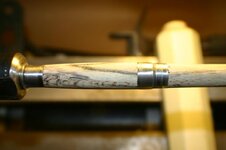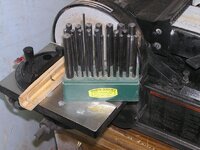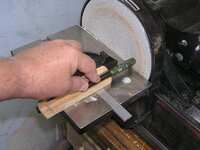You are using an out of date browser. It may not display this or other websites correctly.
You should upgrade or use an alternative browser.
You should upgrade or use an alternative browser.
End Mill Chipping Wood.
- Thread starter Sabaharr
- Start date
Signed-In Members Don't See This Ad
Signed-In Members Don't See This Ad
texasfootball21
Member
Are you using the mill in a drill press? You might be going to fast. I had a problem with uneven cuts and I fixed it by:
1) Getting a new 6 blade cutter head from Daniel.
2) Making sleeves that fit the barrels I was cutting.
3) Setting my drill press on its SLOWEST speed.
Can you provide a little more information on how you mill?
As for salvaging the blank, you could always try an "oops band." Cut off the end and add a piece of another wood, trying to make it look like you meant for it to happen. Or you could try to solve your milling problem and attempt to mill a bit more to straighten it out. This is a gamble because it may ruin the blank if it is too short to be used with the kit. Looks like a Euro kit from here, I might give it a shot if you don't like the "oops band" idea.
Good luck.
1) Getting a new 6 blade cutter head from Daniel.
2) Making sleeves that fit the barrels I was cutting.
3) Setting my drill press on its SLOWEST speed.
Can you provide a little more information on how you mill?
As for salvaging the blank, you could always try an "oops band." Cut off the end and add a piece of another wood, trying to make it look like you meant for it to happen. Or you could try to solve your milling problem and attempt to mill a bit more to straighten it out. This is a gamble because it may ruin the blank if it is too short to be used with the kit. Looks like a Euro kit from here, I might give it a shot if you don't like the "oops band" idea.
Good luck.
Last edited:
Sabaharr
Member
I am using the mill in a hand drill. THe kit is actually a CIGAR. I was thinking of CA and sawdust to fill but it would be a bit darker. Better than holes though. The mill as a 4 blade. I just got a 6 blade and it clogs up so fast I can barely get a thin shaving off the blank before I have to stop and dig out the clogs. I will give the thin CA a try.
Stephen
Stephen
Fred
Member
!st - STOP using a hand drill unless you are holding the blank in a vise or anything BUT your hand. Can you imagine the damage to your hand if 'something' happened and it grabbed you!
Even if you are using a device to hold the blank there still is a good chance that you are not starting off level to the face of the end of the blank. This may be allowing the end mill to 'hog' out too much wood on one side as it first starts cutting. This can often rip out the edges.
Try developing a method whereby you can (a) mount the end mill in a chuck on your lathe. There are MT chucks available to fit in place of the live center, or, (b) USE a drill press with the vise holding the blank. If you get this type of setup going, you can drill the blanks on the lathe as well.
If you still continue to get tear outs then your problem is elsewhere, like maybe a very dull end mill.
IF you have sander you can always make a sled to hold the blank and sand the ends of the blank. Just be sure to have a holddown device to ensure the blank doesn't get crooked as it goes over the sandpaper.
Even if you are using a device to hold the blank there still is a good chance that you are not starting off level to the face of the end of the blank. This may be allowing the end mill to 'hog' out too much wood on one side as it first starts cutting. This can often rip out the edges.
Try developing a method whereby you can (a) mount the end mill in a chuck on your lathe. There are MT chucks available to fit in place of the live center, or, (b) USE a drill press with the vise holding the blank. If you get this type of setup going, you can drill the blanks on the lathe as well.
If you still continue to get tear outs then your problem is elsewhere, like maybe a very dull end mill.
IF you have sander you can always make a sled to hold the blank and sand the ends of the blank. Just be sure to have a holddown device to ensure the blank doesn't get crooked as it goes over the sandpaper.
texasfootball21
Member
Are you using sleeves or trimmer shafts that fit in the barrel with no or little play?
I used to try to use a shaft that was too small and it worked out horribly.
I used to try to use a shaft that was too small and it worked out horribly.
hughbie
Member
to me, that looks more like the chipping is coming from turning instead of the end mill. i take the end mill to the blank before i even mount it on the mandrel.......those chips look like you have a dull lathe tool......IMHO
BigShed
Member
I have both the 4 blade and the 6 blade end mills and can't remember the last time I used either.
Only use my disk sander now with a little jig to hold the blank square to the disk, far more accurate than the end mill.
For final squaring up after finishing I use a sander mill (copied from firefyter-mt ) and that works especially well. Haven't had a gap between kit and blank for a long time.
) and that works especially well. Haven't had a gap between kit and blank for a long time.
Only use my disk sander now with a little jig to hold the blank square to the disk, far more accurate than the end mill.
For final squaring up after finishing I use a sander mill (copied from firefyter-mt
KenV
Member
The texture on the surface (as seen in the photos) suggests pretty punky wood. Thin CA or white wood glue mixed 50/50 with water is probably needed to wick into the ends and firm them up. I like spalted woods, but many times they need help to be usable.
leehljp
Member Liaison
For final squaring up after finishing I use a sander mill (copied from firefyter-mt) and that works especially well. Haven't had a gap between kit and blank for a long time.
Same here, except I bought mine from Lee/firefyter-mt. I use the regular mill (4 blade carbide) to get close on most blanks and then use the sander. On delicate blanks or complex blanks, I use a sander or my saw with a jig, then finish with the sander mill.
Bellsy
Member
A Sanding Mill will prevent this from happpening to softwoods.
My 2 cents.
Bellsy
My 2 cents.
Bellsy
Sabaharr
Member
Looks like I will have to find a way to retire my end mill. I don't like using a different process for different things if I can help it. The chipping was definately from the mill though. I can shave with my tools.
Paul in OKC
Member
I use a pen mill, in a cordless hand drill, AND hold the blanks by hand. So now that I do some no-nos, I wouldn't give up on it. I have used CA on the ends of softer woods. Mill close to the tube, then CA it, then finish. I put the drill on full tilt with light touches. Works well for me!
warreng8170
Member
I use a pen mill, in a cordless hand drill, AND hold the blanks by hand. So now that I do some no-nos, I wouldn't give up on it. I have used CA on the ends of softer woods. Mill close to the tube, then CA it, then finish. I put the drill on full tilt with light touches. Works well for me!
This is exactly what I do (although I do wrap the blank in a washcloth before I grab it). It works great for me until my mill starts to get dull. Then one of two things happens. The mill just spins without taking off any material or I get a catch and tears out a chunk. I just ruined a nice piece of Koa the other day because of a dull mill.
bruce119
Member
MikeInMo
Member
I use a pen mill, in a cordless hand drill, AND hold the blanks by hand. So now that I do some no-nos, I wouldn't give up on it. I have used CA on the ends of softer woods. Mill close to the tube, then CA it, then finish. I put the drill on full tilt with light touches. Works well for me!
This pretty well describes what I do. The softness of the wood determines how soon/how often I soak it with CA.
If I understand the process, the end mill is used to make the end perpendicular to the tube centerline and/or remove slightly extra untubed length. If the hole is drilled perpendicular to the end to start with, the end mill is unnecessary, assuming the extra blank length without tube is removed with tablesaw or such. Determining the length to cutoff is easy with a depth guage (Grizzly...$6).
Paul in OKC
Member
The only way your hole will be perpendicular with the end of the blank is if the tube fits perfectly into the perfectly drilled perfectly straight starting hole that is perfect. Did I say stuff needs to be perfect for that to happen? If not, ........well, you get the idea. The end of the blank needs to be perpendicular to the tube, yes that is the purpose of the mill. Otheres as said above use the disc sander instead with good results.
GouletPens
Member
Why not just stabilize your soft woods and it will make everything better including end milling. You can get it done by someone here or do it yourself with vacuum and Ultraseal. I've used Ultraseal and that stuff is the real deal. It makes it almost impossible to tear out any wood.
ngeb528
Member
I've had that happen with softer woods on the lathe. I end up sanding with 600 or 800 grit to get nice fine sanding dust. I leave it on the blank and kind of push it into the voids at the end, then I do a quick coat of CA.
That helps fill in little voids, if the void is bigger, I'll actually push a bunch of sanding dust to the end(s) of the blank and pack it in the void then flood it with thin CA and hit it with accelerator.
Pull the bushing away from the end of the blankso it doesn't get stuck.
That helps fill in little voids, if the void is bigger, I'll actually push a bunch of sanding dust to the end(s) of the blank and pack it in the void then flood it with thin CA and hit it with accelerator.
Pull the bushing away from the end of the blankso it doesn't get stuck.



